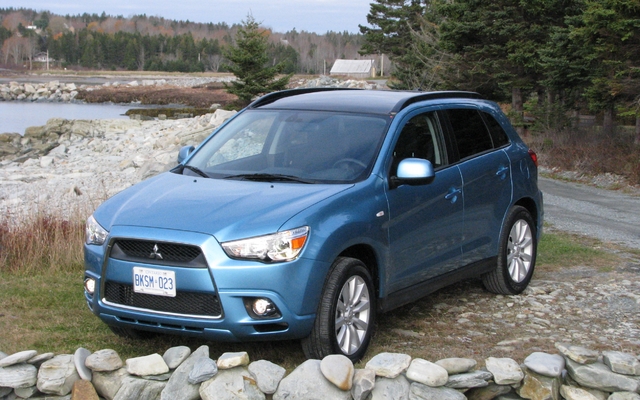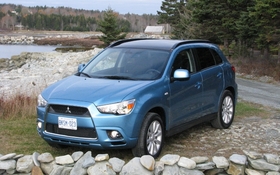2011 Mitsubishi RVR: Wrong Target Market?

| Strong points |
|
|---|---|
| Weak points |
|
Lunenburg, Nova Scotia. Mea culpa: At first glance of the new Mitsubishi RVR, I thought I was looking at a Toyota Matrix. But no, it was the compact Recreational Vehicle Runner, which Mitsubishi is pitching against the Hyundai Tucson, Kia Sportage and Nissan Juke.
The surprising fact here is that the two Korean competitors are longer (105 mm) and wider (50 to 84 mm) than the others, and therefore feature more cargo space.
This is also surprising because at $21,998 (starting price), the RVR is $2,000 more costly than the Nissan Juke. And yet the latter is more powerful with a significantly more modern turbo engine with direct fuel injection.
The RVR is built on the Outlander’s revised platform (i.e. "slimmer platform") and equipped with the Lancer’s 2.0-litre four-cylinder engine. While some like this "international" engine (developed in collaboration with Chrysler and Hyundai) in Mitsubishi’s compact sedan, its 148 hp and 145 lbs-ft of torque don’t have what it takes to dynamically propel a larger vehicle.
The RVR has tried to shed some pounds, but it still runs out of breath easily and its accelerations lack any kind of depth. What’s more, at the AJAC Test Festival, its 0-100 km/hr run clocked in at 11.5 seconds – that’s downright slow. Meanwhile, going from 80-120 km/hr took 9.2 seconds, which is nearly a second more than the Korean utility vehicles. In other words, we are anxiously awaiting the RVR’s Evo turbo...
Eats like a bird . . . really?
Being bulky certainly has a negative impact on fuel consumption. Instead of the promised 7.6 L/100 km for city driving, we recorded an average of 9 L/100 km – and we mostly took the RVR out the highway.
We did not have the pleasure (?) of testing the RVR with a five-speed manual gearbox (note: that’s five, not six). This version comes with two powered wheels only.
On the contrary, our test version was the fully equipped GT ($28,498) with automatic climate control, rain-sensing windshield wipers, 18-inch wheels, keyless start and a huge panoramic roof whose sides light up at night with little LED lights. It’s very cute . . . but totally useless.
The only transmission on the GT is a CVT that, unlike most of its kind, delivers rather noisy and unrefined upshifts. Due to the lack of power, this CVT forces the driver to regularly handle the six virtual speeds. On the GT, shifting is done via the steering wheel (we like) but on the less "luxurious" versions you’ll have to make do with a stick shift.
Recognized qualities
The shortcomings of the RVR’s engine do not detract from Mitsubishi’s renowned sports handling. Even though it has power steering, it connects beautifully and precisely with the road. Plus, the all-wheel drive (optional) really sticks the vehicle to the asphalt and includes the 50:50 lock mode.
The suspension is firmer than all other vehicles in its category, to the point that many will find it uncomfortable. It will definitely jostle you as you drive over uneven surfaces, plus an unpleasant sound from the shocks resounds through the interior.
Not beyond reproach
The interior suffers from very poor soundproofing that does nothing to counter wind noise, which we heard whistling on the windshield all too well. And as for the interior, the dashboard is very simple, bordering on boring, with a mere one or two touches of chrome breaking the monotony.
Shall I continue? The seats are under-stuffed and covered with synthetic fabric that is rough to the touch (that said, it is durable and easy to clean).
Also, there’s no leather available, even though the Korean competitors offer it. In the back, the bench can either fold down or incline, but it neither moves forward or back, unlike many other utility vehicles.
And yet, the interior fit and trim is well done and the assembly is good. The cargo hold is not the most generous in town, but when the seatback is down, there is a decent amount of space, even for those who like to spend their savings at Ikea.
Catching up to its class…
Mitsubishi is trying to add a little frosting on the RVR cake with voice-activated Bluetooth, cruise control, audio controls on the steering wheel, and heated seats.
For starters, I should point out that the seats heat in a very irregular fashion – sometimes too much, sometimes too little. And secondly, no matter how you weigh out the equation, you just can’t opt for a vehicle that lacks panache and whose offering comes up short compared to the competition – or what it considers to be its competition.
This is especially true when you consider that there are other more interesting vehicles available for approximately the same price. There’s the Subaru Impreza wagon that comes factory-standard with AWD – not to mention the Jeep Compass/Patriot that starts at less than $16,000!
In short, this Japanese automaker has got to make some adjustments if it wants to meet is objective of 8,500 RVRs sold annually (the same amount as the Outlander).











